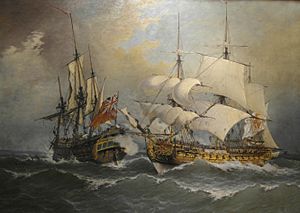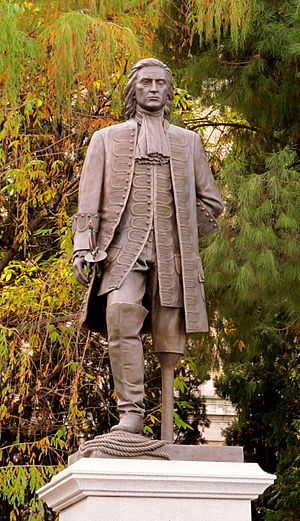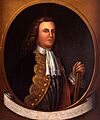Blas de Lezo facts for kids
Quick facts for kids
Blas de Lezo
|
|
|---|---|
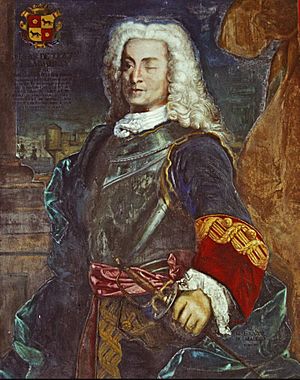
Portrait of Lezo, Museo Naval de Madrid
|
|
| Birth name | Blas de Lezo y Olavarrieta |
| Born | February 3, 1689 Pasajes, Guipúzcoa, Spain |
| Died | September 7, 1741 (aged 52) Cartagena de Indias, New Granada |
| Allegiance | |
| Service/ |
Royal Spanish Navy |
| Years of service | 1704–1741 |
| Rank | Admiral |
| Battles/wars | War of the Spanish Succession |
Blas de Lezo y Olavarrieta (born February 3, 1689 – died September 7, 1741) was a brave Spanish navy officer. He is most famous for leading the Spanish forces to a huge victory in the Battle of Cartagena de Indias in 1741. This battle took place in what is now Colombia. His forces defeated a much larger British invasion fleet.
Throughout his career, Lezo was seriously wounded many times. He lost his left eye, his left hand, and couldn't move his right arm well. His left leg was also amputated after being hit by a cannonball. He saw his injuries as signs of his bravery. He didn't even wear an eye patch to hide his blind eye! His wounds showed everyone the battles he had fought, earning him respect from other soldiers and officers.
Lezo's amazing defense of Cartagena de Indias against a huge British fleet made him one of the most heroic figures in Spanish history. Many people consider him one of the greatest strategists in naval history.
Contents
Who Was Blas de Lezo?
Early Life and First Injuries
Blas de Lezo was born in Pasajes, a town in the Basque Province of Guipúzcoa, Spain. He went to school in France. In 1701, he started his naval career as a midshipman in the Franco-Spanish navy.
In 1704, he fought in the War of the Spanish Succession. He was part of the Franco-Spanish fleet fighting against Britain and the Netherlands. During the Battle of Vélez-Málaga, a cannonball hit his left leg. It had to be amputated below the knee.
More Battles and More Wounds
After his first injury, Lezo was promoted to ensign. He helped defend places like Peñíscola in Spain and Palermo in Sicily. His bravery in these actions led to another promotion, this time to ship lieutenant.
In 1707, he helped defend the French naval base of Toulon. During this battle, he lost his left eye. By 1713, he was promoted to captain. In 1714, during the Siege of Barcelona, he lost the use of his right arm. Later in this campaign, his ship captured a British merchant ship called the Stanhope.
By the time he was 25, Blas de Lezo had lost his left eye, his left leg below the knee, and the use of his right arm. Because of these injuries, people sometimes called him "Patapalo" (Pegleg) or "Mediohombre" (Half-man). However, there's no proof these nicknames were used when he was alive.
Adventures in the Americas
From 1720 to 1728, Lezo served in the Pacific Ocean. He captured two French ships, but this happened in the Atlantic, not the Pacific. He arrived in Callao, Peru, in January 1720. In 1725, he got married in Peru.
Return to the Mediterranean Sea
In 1730, Lezo returned to Spain. He was promoted to lead the Mediterranean Fleet. He sailed to the Republic of Genoa to make them pay a large amount of money they owed to Spain. He threatened to bombard the city if they didn't pay.
In 1732, Lezo helped lead a huge expedition to recapture the cities of Oran and Mers-el-Kébir from the Ottoman Empire. This expedition had over 300 ships and about 28,000 soldiers! After winning, the enemy leader tried to surround Oran again. Lezo returned with six ships and 5,000 men. He fought off the Algerian pirates after a tough battle.
Not satisfied, Lezo took his ship into the pirates' stronghold at Mostaganem Bay. This place was defended by two forts and 4,000 soldiers. He caused a lot of damage to the forts and the town. For months, he blocked the sea, stopping the Algerians from getting help. This gave the Spanish time to secure Oran's defenses. He had to return to Cádiz when an illness spread among his crew.
The Battle of Cartagena de Indias
In 1734, King Philip V promoted Blas de Lezo to Lieutenant General of the Navy. In 1737, he returned to South America. He became the General Commander of the Spanish fleet in Cartagena de Indias, which is in modern-day Colombia. He arrived just before a big conflict between Britain and Spain began. This war was called the War of Jenkins' Ear.
British Attacks Begin
At the start of the war, British Admiral Edward Vernon attacked several Spanish outposts in America. He captured Portobelo (in Panama), destroyed its defenses, and then left it unprotected.
Vernon tried to attack Cartagena de Indias three times. Both Vernon and the British governor of Jamaica, Edward Trelawny, saw this Spanish gold shipping port as a very important target.
The first attempt was in March 1740. It was a small attack to gather information. Vernon wanted to learn about the city's layout, how many troops were there, and how strong their defenses were.
In May, Vernon came back to Cartagena de Indias with 13 warships. He wanted to test the city's defenses again.
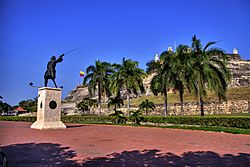
The Main Attack
The main attack on Cartagena de Indias happened from March 13 to May 20, 1741. The British gathered a huge fleet of 196 ships. They had over 2,620 cannons, 10,000 soldiers, 12,600 sailors, and 4,000 new recruits from Virginia. They even had 1,000 Jamaican slaves to help with building.
Cartagena de Indias had between 3,000 and 6,000 defenders. These included regular soldiers, local fighters, and native archers. There were also six Spanish warships and their crews. Blas de Lezo's biggest advantage was a very strong main fortress and many smaller forts.
On the evening of April 19, the British launched a huge attack on San Felipe, the main fort. Three groups of soldiers, supported by Jamaicans and British companies, moved in the dark. They were helped by heavy cannon fire from the British ships. The British fought their way to the base of the fort's walls. But they could not get past Lezo's strong defense. They had to retreat to Jamaica in late May. Many British soldiers died from fighting and disease.
After the Battle
News of this huge British defeat reached Europe in June 1741. It had a big impact. The British government, led by Robert Walpole, soon fell apart. Spain kept control of its most important colonies in the Americas. This included the vital port of Cartagena de Indias. This victory helped protect Spain's trade routes across the Atlantic.
The defeat also affected a bigger war, the War of the Austrian Succession. It encouraged France and Spain to move against Austria.
Death of a Hero
Blas de Lezo died four months after the Battle of Cartagena de Indias. A record from that time says he died from a fever, likely typhus. The exact place where he was buried is not known.
He was honored later for his role in defending Cartagena de Indias. A square and a street in the modern city are named after him. A modern statue stands in front of the Castillo San Felipe de Barajas fort. In 2014, a large statue of Lezo was put up in Madrid's Plaza Colón.
Legacy and Recognition
Blas de Lezo is remembered as a great naval hero. Several Spanish warships have been named Blas de Lezo in his honor.
- An Elcano-class cruiser, named General Lezo, built in 1884.
- A Blas de Lezo-class cruiser built in 1924.
- The former USS Noa (DD-841), a Gearing-class destroyer, served from 1978 to 1991.
- An Álvaro de Bazán-class frigate, F103, was launched in 2003 and started service in 2004.
The Colombian Navy also had a ship named after Blas de Lezo:
- ARC Blas de Lezo (BT-62), a former gasoline tanker, served from 1947 to 1965.
In 2013, the Naval Museum of Madrid held an exhibition about Blas de Lezo. It included portraits, uniforms, and battle plans.
Images for kids
See also
 In Spanish: Blas de Lezo para niños
In Spanish: Blas de Lezo para niños


